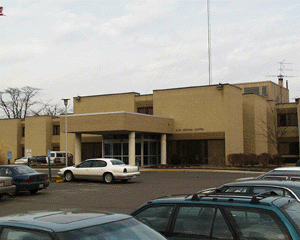Allen Hospitals
 At the turn of the century, St. Joseph’s in Lorain was the only hospital in Lorain County. If someone needed an operation or required serious medical attention, they would likely have to go to Cleveland for care. In 1902, Oberlin College President John Barrows made the case for building a hospital in Oberlin. In a time when pneumonia was a common and deadly ailment and typhoid and scarlet fever outbreaks routine, Barrows argued that Oberlin College’s students were at an age when they were more susceptible to these illnesses.
At the turn of the century, St. Joseph’s in Lorain was the only hospital in Lorain County. If someone needed an operation or required serious medical attention, they would likely have to go to Cleveland for care. In 1902, Oberlin College President John Barrows made the case for building a hospital in Oberlin. In a time when pneumonia was a common and deadly ailment and typhoid and scarlet fever outbreaks routine, Barrows argued that Oberlin College’s students were at an age when they were more susceptible to these illnesses.
Barrows’ case became more compelling a few months later when he died of pneumonia. College trustees wanted to build a hospital, but the College didn’t have enough funds.
In 1906, a group of prominent Oberlin citizens took it upon themselves to raise the money by going door-to-door seeking $5 per person. On August 17, 1907, the Oberlin Hospital opened as a modest eight-bed facility in a two-story rented home at 21 S. Cedar St. Room charges were $10 per week. Within a year, the hospital had accumulated a small surplus.
Though successful, the first hospital was inadequate from the start. It served as an infirmary, birthing place, a surgery center, and morgue. It had more patients than it could accommodate.
The hospital’s Women’s Auxiliary began raising funds for a larger facility in 1910. Proceeds helped purchase land in 1914 at 200 W. Lorain St., the site of the current Allen Community Hospital.
Around this time, noted surgeon Dudley Peter Allen (Class of 1875) and his wife, Elisabeth Severance Prentiss Allen, pledged to help build the hospital as well as an art museum for Oberlin. Allen, who was a third-generation Oberlin physician, died of pneumonia in 1915 before either project became a reality. Elisabeth took responsibility for both projects. Allen’s bequest of $100,000 for the hospital was insufficient, so Elisabeth pledged another $50,000 to ensure its completion.
In 1925, Allen Memorial Hospital opened as a 25-bed facility owned and operated by the College. The single-story, California-mission style building has undergone renovations through the years, including construction of the Oberlin Clinic, a second-story expansion, and most recently, the addition of a $4.6 million surgery center and a diagnostic imaging center.
The city took ownership of the hospital in 1954. At its peak, the hospital had 109 beds. In 1990, the hospital received a significant and unexpected contribution: Lillian Prall Ludlow, longtime personal secretary to Elisabeth Allen, named the hospital the beneficiary of her estate. Her $2 million gift established the Allen Memorial Hospital Foundation.
Within a decade, however, the hospital fell on hard times. The hospital merged with the Oberlin Clinic in 2000 to become Oberlin Medical Center. By the end of that year, the hospital lost $6 million and nearly closed its doors. A deal between Oberlin College and Community Health Partners kept the hospital open. The College offered $2 million to buy the land on which the hospital stands, and lease it to the medical center for $1 a year in perpetuity. Before the sale, the city transferred the title to the land to the medical center. The College's acquisition of the property assured the integrity of the campus by protecting a portion of its west boundary. Today, Community Health Partners operates Allen Community Hospital as a rural Critical Access Hospital with 25 beds.
Sources: Geoffrey Blodgett’sOberlin History (2006); Allen Community Hospital Foundation; Elyria Chronicle-Telegram newspaper archives